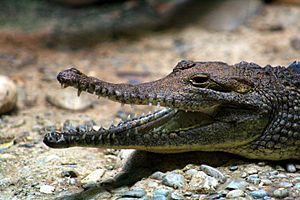Mouth facts for kids
The mouth is an opening in the face. It is the first part of your alimentary canal (which is your digestive system). This is where you start to chew your food. Your mouth has teeth to help you chew.
In humans, the mouth is also very important for communication. Your tongue, lips, and jaw are all parts of your mouth. They help you make the many sounds needed for human language. People also kiss and show their feelings with their mouths.
Contents
How Mouths Are Built
Mouths in Different Animals

In animals with backbones (called vertebrates), the first part of the digestive system is the buccal cavity, which is just another name for the mouth.
Fish Mouths
A fish's mouth is separate from its gill area. Water flows into the mouth, goes over the gills, and then leaves through the operculum (gill cover) or gill slits. Almost all fish have jaws. They can grab food with their jaws. Most fish eat by opening their jaws wide, expanding their throat, and sucking in food. The food might be held or chewed by teeth. These teeth can be in their jaws, on the roof of their mouth, in their throat, or on their gill arches.
Amphibian Mouths
Almost all adult amphibians (like frogs and salamanders) eat meat. Many catch their prey by quickly flicking out a long, sticky tongue. They then pull the prey back into their mouth. They hold the prey with their jaws and swallow it whole, without much chewing. Amphibians usually have many small, hinged teeth. These teeth break off and are replaced often. Most amphibians have one or two rows of teeth in both jaws. Some frogs do not have teeth in their lower jaw. Many amphibians also have vomerine teeth attached to the bone on the roof of their mouth.
Reptile Mouths
The mouths of reptiles are quite similar to those of mammals. Crocodilians (like alligators and crocodiles) are the only reptiles with teeth that are held firmly in sockets in their jaws. They can replace each of their about 80 teeth up to 50 times in their lives. Most reptiles eat meat or insects. However, turtles eat plants. Turtles do not have teeth that are good for chewing their food well. So, they often have gastroliths (small stones) in their stomach to help grind the plant material. Snakes have a very flexible lower jaw. The two halves of their lower jaw are not strongly connected. They also have many other joints in their skull. These special features let them open their mouths very wide. This allows them to swallow their prey whole, even if the prey is wider than the snake itself!
Bird Mouths
Birds do not have teeth. Instead, they use other ways to grab and break up their food. Their beaks come in many sizes and shapes, depending on what they eat. Beaks are made of long jaw bones. The top part of the beak can have a hinge, letting the beak open wider. The outside of beaks is covered by a thin, tough layer called keratin. Birds that drink nectar, like hummingbirds, have special brushy tongues. These tongues help them suck nectar from flowers.
Mammal Mouths
In mammals, the mouth (buccal cavity) usually has a roof made of the hard and soft palates. The floor is the tongue. The mouth is surrounded by the cheeks, salivary glands, and upper and lower teeth. The upper teeth are in the upper jaw. The lower teeth are in the lower jaw. The lower jaw connects to the temporal bones of the skull. The lips are soft and fleshy. They shape the entrance to the mouth. The mouth leads into the pharynx, which then leads to the oesophagus.
Other Things Mouths Do

Crocodilians that live in hot, tropical places can open their mouths wide. This helps them cool down by letting water evaporate from the lining of their mouth. Some mammals also pant to cool down. Panting increases how much water evaporates from their lungs, tongue, and mouth. Birds also avoid getting too hot by fluttering their throat skin. This is similar to how mammals pant.
Many animals use their mouths to show they are a threat. They might open their mouths wide, show their teeth clearly, or flash the bright colors inside their mouth. This display lets animals see how strong their opponent is. It can help prevent actual fights.
Some birds open their beaks wide when they are scared or showing a threat. Some birds also hiss or breathe heavily. Others clap their beaks together.
Mouths are also used to make sounds for communication. To make sounds, air is pushed from the lungs over vocal cords in the voice box (larynx). In humans, the throat, soft palate, hard palate, the ridge behind your teeth, tongue, teeth, and lips are all called "articulators." They help produce speech. Changing where your tongue is, or moving your lips, changes how air flows from your lungs. This creates many different sounds.
In frogs, sounds can be made louder using sacs in their throat. These vocal sacs can inflate and deflate. They act like speakers to send the sound outside. A bird's song is made by air flowing over a vocal organ called the syrinx. This organ is at the base of the trachea (windpipe). For each burst of song, the bird opens its beak and then closes it. The beak might move a little and help with the sound, but the song itself comes from the syrinx.
See also
 In Spanish: Boca para niños
In Spanish: Boca para niños


